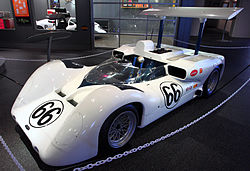Chaparral 2E
 | |||||||||||
| Category | Group 7 | ||||||||||
|---|---|---|---|---|---|---|---|---|---|---|---|
| Constructor | Chaparral Cars | ||||||||||
| Designer(s) | Jim Hall Hap Sharp | ||||||||||
| Production | 1965 | ||||||||||
| Technical specifications | |||||||||||
| Chassis | Reinforced aluminum alloy monocoque, fiberglass body | ||||||||||
| Suspension (front) | unequal-length double wishbones, coil springs over tubular shock absorbers, anti-roll bar, anti-dive geometry | ||||||||||
| Suspension (rear) | unequal-length reversed lower wishbones, single top links, twin trailing arms, coil springs over shock absorbers, anti-roll bar, anti-dive/squat geometry | ||||||||||
| Length | 158 in (4,000 mm) | ||||||||||
| Width | 64 in (1,600 mm) | ||||||||||
| Height | 27 in (690 mm) | ||||||||||
| Axle track | 53.5 in (1,360 mm) (front) 52 in (1,300 mm) (rear) | ||||||||||
| Wheelbase | 90 in (2,300 mm) | ||||||||||
| Engine | Chevrolet 327 cu in (5,359 cc) all-aluminum small-block OHV V8 naturally aspirated mid-engined, longitudinally mounted | ||||||||||
| Transmission | Chaparral 2-speed automatic | ||||||||||
| Power | 450–475 hp (336–354 kW) @ 6,800 rpm[3] | ||||||||||
| Weight | 1,550–1,560 lb (700–710 kg) | ||||||||||
| Brakes | Solid discs | ||||||||||
| Tires | Firestone Chaparral cast-alloy one-piece center-locking 16 in wheels | ||||||||||
| Competition history | |||||||||||
| Notable entrants | |||||||||||
| Debut | 1966 Player's 200 | ||||||||||
| |||||||||||
The Chaparral 2E is a Group 6 sports prototype race car designed and developed by both Jim Hall and Hap Sharp, and built by American manufacturer Chaparral, which campaigned in the Can-Am Championship series, in 1966.[4][5][6][7]
References
[edit]- ^ "1966 Chaparral 2E Chevrolet Specifications". Ultimatecarpage.com.
- ^ "Petroleum Museum | Chaparral 2E". petroleummuseum.org.
- ^ David, Dennis (May 6, 2009). "Chaparral 2E".
- ^ "The Chaparral 2E Was A Guiding Light in Race Car Aerodynamics". MotorTrend. October 31, 2016.
- ^ conceptcarz.com/s3324/chaparral-2e.aspx
- ^ "Classic: Chaparral 2".
- ^ "Chaparral 2E". Car and Driver. June 1, 2007.


 French
French Deutsch
Deutsch